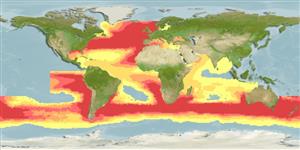Actinopterygii (ray-finned fishes) >
Perciformes (Perch-likes) >
Bramidae (Pomfrets)
Etymology: Brama: Old French, breme, bresme = a fresh water fish; 1460 (Ref. 45335).
Environment / Climate / Range
Ecology
Marine; pelagic-neritic; oceanodromous (Ref. 51243); depth range 0 - 1000 m (Ref. 4388), usually 0 - 200 m (Ref. 89422). Subtropical; 12°C - 24°C, preferred 23°C (Ref. 107945); 65°N - 70°S, 180°W - 180°E
Atlantic, Indian and South Pacific (Ref. 47377). Western Atlantic: Nova Scotia, Canada and Bermuda (Ref. 7251) to Belize and the Antilles (Ref. 26340). Also found in Brazil (Ref. 47377) and in Argentine (Ref. 2806). Eastern Atlantic: central Norway (Ref. 6697) southward to Algoa Bay, South Africa (Ref. 4388). Highly migratory species, Annex I of the 1982 Convention on the Law of the Sea (Ref. 26139).
Size / Weight / Age
Maturity: Lm ? range ? - ? cm
Max length : 100.0 cm TL male/unsexed; (Ref. 26340); common length : 40.0 cm SL male/unsexed; (Ref. 3397); max. published weight: 6.0 kg (Ref. 4645); max. reported age: 9 years (Ref. 33866)
An oceanic and epipelagic species, also found to 1,000 m depth (Ref. 27121). Occasionally comes close to shore (Ref. 9563). Seasonal migrant occurring in small schools, movements apparently temperature-related. Opportunistic feeder on small fishes, cephalopods, amphipods, and euphausiids. Sold fresh and frozen; eaten steamed, fried, broiled and baked (Ref. 9988).
Life cycle and mating behavior
Maturity | Reproduction | Spawning | Eggs | Fecundity | Larvae
Gomes, J., 1990. Bramidae. p. 758-764. In J.C. Quero, J.C. Hureau, C. Karrer, A. Post and L. Saldanha (eds.) Check-list of the fishes of the eastern tropical Atlantic (CLOFETA). JNCT, Lisbon; SEI, Paris; and UNESCO, Paris. Vol. 2. (Ref. 4936)
IUCN Red List Status (Ref. 115185)
CITES (Ref. 94142)
Not Evaluated
Threat to humans
Harmless
Human uses
Fisheries: commercial
Tools
Special reports
Download XML
Internet sources
